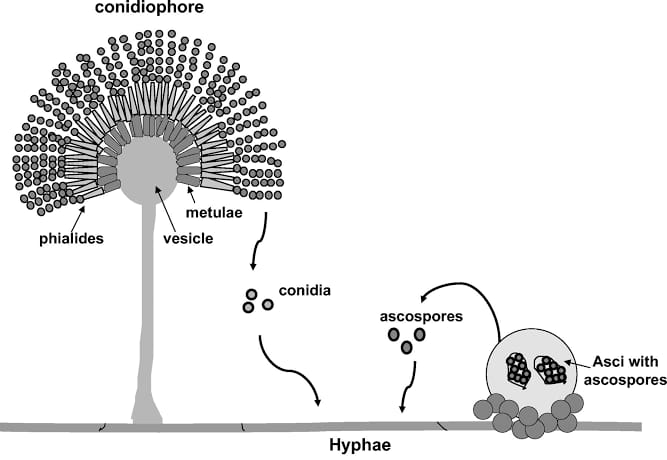
Differentiate between sporangiospores and conidiospores?
Answer
563.1k+ views
Hint: Sporangiospores are produced within a sac-like structure called the sporangia, it develops on sporangiophores. Conidia are produced on conidiophores.
Step by step answer:Conidiospores:- Conidia are the asexual, non-motile spores. They are made by mitosis. Conidia are not enclosed in a protective sac, unlike sporangiospores. Conidia are haploid cells that are identical to the haploid parent. Asexual reproduction in ascomycetes is done by the formation of conidia that are borne on stalks called conidiophores. The morphology of these conidiophores is distinctive between different species and, just before the development of molecular techniques, widely used for identification of species for example Metarhizium.

Sporangiospore:- The asexual propagules is formed inside a sporangium. Sporangiospores can be mostly spherical and also cylindrical, with the help of a process that involves cleavage of the cytoplasm and is named sporangiospores. These spores are thin-walled, hyaline and pale in colour, and globose and ellipsoid in shape. One to 50,000 sporangiospores are to be formed in a single sporangium. When mature, sporangiospores are released by the help of breakdown of the sporangial wall, or if the entire sporangium is dispersed as a unit. Sporangiospores are produced by fungi of the Chytridiomycetes and Zygomycetes, as well the Oomycetes, which is a group of fungi that is unrelated to the true fungi phylogenetically.

Note: Conidiospores are borne externally in chains on an aerial hyphae which is called a conidiophore. sporangiospores are produced within a sporangium on an aerial hyphae which is called a sporangiophore.
Step by step answer:Conidiospores:- Conidia are the asexual, non-motile spores. They are made by mitosis. Conidia are not enclosed in a protective sac, unlike sporangiospores. Conidia are haploid cells that are identical to the haploid parent. Asexual reproduction in ascomycetes is done by the formation of conidia that are borne on stalks called conidiophores. The morphology of these conidiophores is distinctive between different species and, just before the development of molecular techniques, widely used for identification of species for example Metarhizium.

Sporangiospore:- The asexual propagules is formed inside a sporangium. Sporangiospores can be mostly spherical and also cylindrical, with the help of a process that involves cleavage of the cytoplasm and is named sporangiospores. These spores are thin-walled, hyaline and pale in colour, and globose and ellipsoid in shape. One to 50,000 sporangiospores are to be formed in a single sporangium. When mature, sporangiospores are released by the help of breakdown of the sporangial wall, or if the entire sporangium is dispersed as a unit. Sporangiospores are produced by fungi of the Chytridiomycetes and Zygomycetes, as well the Oomycetes, which is a group of fungi that is unrelated to the true fungi phylogenetically.

Note: Conidiospores are borne externally in chains on an aerial hyphae which is called a conidiophore. sporangiospores are produced within a sporangium on an aerial hyphae which is called a sporangiophore.
Recently Updated Pages
Master Class 12 Business Studies: Engaging Questions & Answers for Success

Master Class 12 Economics: Engaging Questions & Answers for Success

Master Class 12 English: Engaging Questions & Answers for Success

Master Class 12 Maths: Engaging Questions & Answers for Success

Master Class 12 Social Science: Engaging Questions & Answers for Success

Master Class 12 Chemistry: Engaging Questions & Answers for Success

Trending doubts
What is meant by exothermic and endothermic reactions class 11 chemistry CBSE

Which animal has three hearts class 11 biology CBSE

10 examples of friction in our daily life

One Metric ton is equal to kg A 10000 B 1000 C 100 class 11 physics CBSE

1 Quintal is equal to a 110 kg b 10 kg c 100kg d 1000 class 11 physics CBSE

Difference Between Prokaryotic Cells and Eukaryotic Cells




